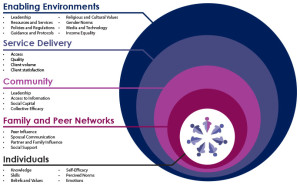The information collected during this step is the foundation of a good strategy or marketing plan because it allows your team to have a better understanding of the current context, health attitudes, norms and practices, media viewing habits and credible sources of information and communication channels (e.g. TV, mobile phones, radio). During this step you should also explore the different policies and laws supported by previous programs and lessons learned through those experiences.
Your situation analysis should consider the social and behavioral determinants, with a special focus on the gender dynamics at each level of the socio-ecological model. Understanding how gender constructs like household decision-making, spousal communication, power relations, traditional values and religious practices, cultural and gender norms, violence and access to opportunities and resources impact health can be what makes or breaks your program.

The following activities can help you further explore the gender dynamics that may impact your program. They can also help tease out economic, social, structural, cultural or educational barriers or facilitators to behavior change that your team should consider as you revise your program. You may also consider doing an updated literature review or additional formative research that looks at gender dynamics in relation to your health issue.
Activities
![]()
Activity 2.1: Identifying the Core Problem
This activity will guide you on how to conduct a root-cause analysis to identify the underlying causes of the health problem and to validate that your current program is addressing these core challenges. Your root-cause analysis should seek to uncover those gender dynamics that are often part of the root cause.![]()
Activity 2.2: Mapping the Community and Social Resources
This activity will guide you on how to explore the environment in which men and women live and can help to better understand the opportunities, social resources, and decision-making power men and women have in a particular community.![]()
Activity 2.3: Examining Power Dynamics and Decision-Making
This activity will guide you on how to organize a power and decision-making matrix that examines the role of power and decision-making within a relationship.![]()

No Comments